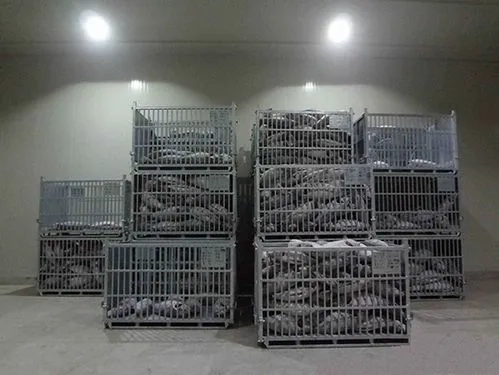Walk-In Freezer Compressor Unit Manufacturers High-Efficiency & Durable
- Fundamentals of modern compressor unit
technology - Technical advantages transforming cold storage efficiency
- Comparison of leading walk-in freezer compressor unit manufacturers
- Customized engineering for specialized refrigeration applications
- Real-world industrial implementation case studies
- Operational best practices for peak performance
- Future developments in commercial refrigeration systems

(compressor unit)
The Vital Role of Compressor Units in Walk-In Freezer Performance
Compressor units serve as the operational core of commercial refrigeration systems. Walk-in freezer performance directly correlates with compressor efficiency. These critical components maintain precise temperature ranges between -10°F to -40°F (-23°C to -40°C), with premium units achieving 30-40% higher operational efficiency than older models. Advanced vapor compression cycles significantly reduce the refrigeration's carbon footprint, with modern variable-speed compressors cutting energy consumption by up to 45% versus constant-speed equivalents.
Technological Advancements Transforming Refrigeration
Contemporary compressor engineering incorporates digitally controlled scroll and screw compressors capable of adjusting capacity between 10-100%. ECM technology enables variable speed operation reducing power consumption during partial load conditions. Eco-friendly refrigerant transitions include R-448A and R-449A with GWP below 1400. Thermal efficiency enhancements include oil management systems maintaining viscosity at extreme temperatures and liquid injection cooling preventing compressor overheating during intensive cycles.
Comparing Commercial Refrigeration Unit Manufacturers
The competitive landscape includes both global corporations and specialized fabricators.
| Manufacturer | COP Range | Sound Rating | Standard Warranty | Specializations |
|---|---|---|---|---|
| Copeland | 1.5-2.1 | 68-72 dB | 5 years | Ultra-low temp applications |
| Bitzer | 1.7-2.3 | 64-69 dB | 6 years | Variable speed systems |
| Hussmann | 1.4-1.9 | 70-75 dB | 4 years | Modular installations |
| Carrier | 1.6-2.2 | 66-71 dB | 5 years | High-ambient performance |
Performance data based on ASHRAE Standard 23.1 testing conditions at -25°F evaporator temperature
Tailored Engineering Solutions for Specific Requirements
Customization addresses critical application parameters: Standard units support configurations from 1HP to 60HP, while specialized projects require engineering consultation. Critical modification areas include explosive environment compressors for petrochemical facilities featuring completely sealed enclosures, extreme-temperature options incorporating secondary compression stages for -60°F (-51°C) applications, and coastal corrosion-resistant packages with epoxy-coated components. Redundancy configurations pair multiple compressors achieving 99.95% operational reliability in pharmaceutical storage.
Industry-Specific Implementation Success Stories
Food distribution: Major Midwest logistics center achieved 36% reduction in operational costs through implementation of variable frequency drive (VFD) compressors with parallel rack systems. Continuous 24/7 operation requires just 8 hours monthly maintenance downtime.
Healthcare applications: Research institution's cryogenic specimen storage maintained consistent -40°F/-40°C with ±0.5°F (±0.3°C) temperature stability. Redundant systems provide backup during quarterly refrigerant maintenance.
Specialized seafood processing: Blast freezing tunnel with custom compressor configuration processes 1,200 pounds of product per hour. Integrated CO2 secondary coolant prevents compressor overload during sudden heat influx from product loading.
Operational Efficiency and Maintenance Protocols
Proactive monitoring prevents 82% of potential failures: Vibration sensors detect early bearing wear, temperature probes identify thermal stress points, and refrigerant analysis sensors predict contamination issues. Critical maintenance protocols involve quarterly coil cleaning preventing 5-7% efficiency degradation, bi-annual oil analysis detecting compressor wear metals, and refrigerant charge verification maintaining optimal subcooling levels.
Compressor Unit Technology Development Trends
Leading manufacturers are implementing IIoT-enabled systems providing predictive maintenance analytics while solid-state cooling technology advances offer future efficiency improvements. R-454C refrigerant transition presents next-generation low-GWP solution requiring modified compressor configurations. Ongoing developments include hybrid systems combining magnetic bearings with traditional compression achieving 92% mechanical efficiency. Industry 4.0 integration enables remote diagnostic capabilities through secure VPN connections, reducing technical response times by up to 68% while optimizing system performance.

(compressor unit)
FAQS on compressor unit
Q: What should I consider when choosing walk in freezer compressor unit manufacturers?
A: Prioritize manufacturers with proven expertise in commercial refrigeration, certifications (e.g., ISO, UL), and a track record of reliable after-sales support. Energy efficiency and compliance with industry standards are also critical factors.
Q: How do walk in freezer compressor unit manufacturer warranties work?
A: Most manufacturers offer warranties covering parts and labor for 1-5 years, depending on the compressor type. Always review warranty terms for exclusions, such as improper installation or lack of routine maintenance.
Q: Are there global walk in freezer compressor unit companies offering custom solutions?
A: Yes, leading global companies provide custom-engineered units for specific temperature ranges, load capacities, or spatial constraints. Request case studies or client references to verify their customization capabilities.
Q: What certifications should reputable walk in freezer compressor unit manufacturers have?
A: Look for ISO 9001 (quality management), UL/CE compliance (safety), and EPA certifications for refrigerant handling. These ensure adherence to environmental and operational safety regulations.
Q: How long do walk in freezer compressor units typically last?
A: With proper maintenance, units last 10-15 years. Lifespan depends on usage intensity, ambient conditions, and timely servicing by certified technicians to prevent refrigerant leaks or motor failures.
















































































































